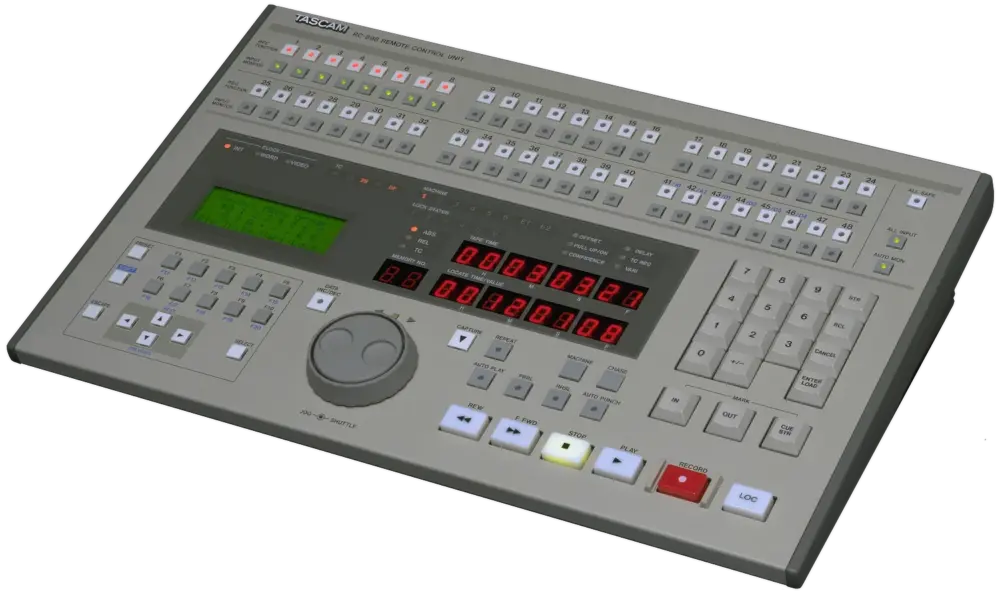Based on the popular TASCAM DA-98HR high-resolution DTRS recorder the TASCAM DS-D98 is the only tape-based machine capable of DSD recording and can be configured in both easy to integrate into any DTRS environment: It is fully compatible with existing DTRS recordings and may be branched together with other DTRS recorders (up to 256 in total).
The Super Audio CD (SACD) format is based upon Direct Stream Digital (DSD) processing, a technology that records audio signals at a high sampling frequency of 2.8224 MHz and converts them to 1-bit data. This achieves unprecedented sonic quality without the decimation and interpolation stages associated with conventional PCM technology. Up until the release of the TASCAM DS-D98 Digital Recorder, recording DSD data was only possible two tracks at a time on a stand-alone recorder, or on a workstation.
The TASCAM DS-D98 is based on the popular TASCAM DA-98HR high resolution DTRS multitrack recorder. The TASCAM DS-D98 can be configured in both a DSD two-track and PCM multitrack format. This new acquisition and mixdown recorder is designed for the high-resolution recording standards of DSD Audio. The TASCAM DS-D98 is the only system where multiple DSD recorders can be synchronised for multitrack recording for up to 32 DSD tracks, and the exclusive tape-based machine capable of SACD recording.
In DSD mode, the unit functions as a 2-track recorder/player with synchronisation of up to 16 units and to other DTRS recorders and features Sony’s SDIF-3 digital I/O. In PCM multitrack mode, the TASCAM DS-D98 Recorder features a selectable 24-bit or 16-bit recording format with 44.1, 48, 88.2, 96, 176.4, 192kHz sampling frequencies. (44.1/48kHz: 8-tracks, 88.2/96kHz: 4-tracks, 176.4/192kHz: 2-tracks). Recordings made on the DS-D98 will be backward compatible with existing DTRS recordings. Additional features include: +/- 6% pitch control, an onboard test tone generator, electronic patchbay, TDIF-1 digital audio interface and D-sub 25 pin 8-channel AES/EBU digital I/O.
Like the TASCAM DA-98HR, the 4U rack mountable DS-D98 features a confidence monitoring function, selectable reference levels, an LCD display on the front panel, set-up data memory on tape, seamless punch I/O with digital cross fade, adjustable peak hold release time level meter and an A/B head playback error rate display function. The unit also supports the RS-422 control (P2 protocol). Its synchronisation capabilities include XLR timecode IN/OUT terminal with an onboard SMPTE synchroniser, Word Sync In/Out/Thru, Machine offset in sub-frame or sample rate accuracy, and Auto Punch I/O in 0.1 frame accuracy.
Features
- Developed by TASCAM and Sony for creation of Super Audio CDs
- The only tape-based machine capable of DSD recording
- Two modes: DSD 2-track and PCM multitrack
- Synchronise up to 16 machines with sample accuracy
- Selectable 24-bit or 16-bit recording format
- Selectable sampling frequencies: 44.1/48 (8 tracks), 88.2/96 (4 tracks), 176.4/192kHz (2 tracks)
- +/- 6% pitch control, onboard test tone generator, electronic patchbay
- Confidence monitoring function, selectable reference levels, LCD display on the front panel
- Set-up data memory on tape, seamless punch I/O with digital cross fade, adjustable peak hold release time level meter
- Sony SDIF-3 interface, TDIF-1 digital audio interface, 8-channel AES/EBU digital I/O standard
- RS-422 control (P2 protocol), XLR timecode I/O with onboard SMPTE synchroniser, Word Sync In/Out/Thru
The TASCAM DS-D98 recorder provides the facility to record using the Direct Stream Digital (DSD) digital audio representation, as employed by the Super Audio CD format, using the convenient industry standard DTRS digital multitrack medium.
Based around the TASCAM DA-98HR recorder, the TASCAM DS-D98 has many features in common with its “parent” unit. PCM recordings made on this unit can be replayed on other DTRS units (subject to the sampling frequency and word length restrictions of the other units) and PCM recordings made on other DTRS units can be replayed on the DS-D98.
The main differences between the TASCAM DS-D98 recorder in DSD mode and the PCM digital audio mode (in which it acts in the same way as a DA-98HR recorder) are: • The recording format and input sources. In DSD mode, the TASCAM DS-D98 uses digital audio I/O in SDIF-3 or DSD raw audio format, or the analogue connectors fitted to the DSD slot board (compared with the TDIF and AES/EBU interfaces of the standard TASCAM DA98HR). In DSD mode, these standard TDIF and AES/EBU interfaces are not used.
- The number of tracks. In PCM mode, the DS-D98 is capable of recording eight, four or two tracks of PCM digital data, depending on the sampling frequency selected. IN DSD mode, the DS-D98 recorder is capable of recording two tracks (per unit).
- Chaining units. For most DTRS units, up to 16 units may be chained together using the built-in synchronisation facilities. With the TASCAM DS-D98, up to 256 DTRS units may be branched together, providing up to 512 tracks of audio.
Key features of the unit include:
- Direct conversion between DSD and analogue signals, using the onboard ∆Σ AD and DA convertors.
- A newly developed VCXO PLL reduces the jitter rate and improves the sonic performance.
- An OS-CON condenser improves sonic performance, decoupling the power supply circuitry from the audio circuitry.
- Filtering: two types are available on the DS-D98: the Standard (GIC) filter, recommended when working with SACD, and the Custom filter for more general work.





